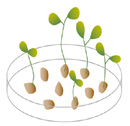
Chapter 18. Chapter 18: Agriculture
What is the focus of the Green Revolution 2.0...?

Guiding Question 18.5
What is the focus of the Green Revolution 2.0, and what are the advantages and disadvantages of this technology?
Why You Should Care
The "Green Revolution 2.0" refers to the next generation of agricultural advances based on genetic modification. The first genetically modified organisms (GMOs) were fruits and vegetables modified for improved flavor or to prevent spoilage during shipment, but the big players among the GMOs are the "commodity" crops, such as corn, soy, and cotton. These crops have been modified to be resistant to herbicides so that entire fields can be sprayed to deter weeds. Some crops have also been modified to express the Bt protein, a natural pesticide that is toxic to most insects and harmless to humans. Both of these modifications have increased yields of crops to unprecedented amounts. Trials of GM have been conducted on animals to make them more nutritious or produce more meat.
GMOs have become highly controversial, but perhaps for the wrong reasons. Most objections to GMOs revolve around the idea that "tampering with nature" makes the food unsafe to eat. All clinical evidence, however, suggests that there isn’t anything harmful about eating GMOs. Experts' major concerns with GMOs are about their environmental impact. The effects of spraying entire fields of herbicide-resistant GMO crops are unclear. The modified genes have also been known to spread into related non-crop plant species. Some of these species are "weeds" that may become resistant to herbicides. Others may be the "wild types" of the crop species, meaning that the important genetic diversity in the ancestors of our crops may be modified or lost through GMOs.
Test Your Vocabulary
Choose the correct term for each of the following definitions:
| Term | Definition |
|---|---|
| Organisms that have had their genetic information modified to give them desirable characteristics such as pest or drought resistance. | |
| An organism that contains genes from another species. | |
| Focuses on the production of genetically modified organisms (GMOs) to increase crop productivity or create new varieties of crops. |
1.
Which of the following about GMOs is FALSE?
| A. |
| B. |
| C. |
| D. |
2.
Bacillus thuringiensis is _________________. (check all that apply)
a. a bacterium
b. the source of the pesticide Bt
c. used to transfer new genes into plant cells
d. harmful to most plants
3.
Plasmids are _________________. (check all that apply)
a. organelles based on chloroplasts
b. small circular pieces of DNA
c. naturally found in bacteria
d. used to transfer new genes into plant cells
4.
After a new gene is inserted into plant cells, the first plants with the gene are grown from:
| A. |
| B. |
| C. |
| D. |
5.
Golden rice is a variety of GMO rice with genes from different organisms (including daffodils and corn) added to make it produce vitamin A in the edible part of the rice. It was developed because most areas of the world with widespread vitamin-A deficiencies (which can cause blindness in children) also consume most of their dietary calories as rice. Choose the correct order of steps for creating golden rice.
| Image | Step |
|---|---|

|
|

|
|

|
|

|
|

|
|

|
|

|
6.
Genetic modification has been used to confer all of the following EXCEPT:
| A. |
| B. |
| C. |
| D. |
7.
Which of the following is a TRUE statement regarding GMOs?
| A. |
| B. |
| C. |
| D. |
8.
The term _______ refers to GMO crops that are engineered to survive being sprayed with a particular kind of herbicide so that weeds around it can be killed easily.
| A. |
| B. |
| C. |
| D. |
9.
MC: The gene for the substance Bt was found in and is used to in GMOs.
10.
To date, _______________ have been genetically modified to have a better nutrient profile.
| A. |
| B. |
| C. |
| D. |
11.
Thought Question: To date, no genetically modified animal has actually been approved for consumption or sale. Why do you think that is?
12.
Thought Question: Golden rice was first developed in 2000 and was re-modified a few years later to produce more vitamin A, but it will only start being grown in 2013, or perhaps later as there is opposition to its production. Can you think of any reasons why?
Short-Answer Questions
Suppose you are a farmer trying to make your farming operation greener. What could you do, given the following circumstances, to improve the sustainability of your farm? Make sure to explain the advantages and disadvantages of each circumstance.
1) You have only grown soybeans in the past.
2) Your farm is located on rolling hills.
3) You have always relied on synthetic fertilizers.
4) You have to irrigate your crops heavily.
5) You have to use a lot of pesticides.
6) You also raise cattle.
2) If the terrain is hilly and crops are planted in straight rows, there is an increased chance of erosion. Solution: Contour farming is a better way to prevent erosion.
3) Synthetic fertilizers can run off into surface water, causing eutrophication, or seep into groundwater, contaminating it. The negative side of the increased plant growth is that the fertilized plants will remove other micronutrients from the soil at an unsustainable rate. Solution: Plant a nitrogen-fixing cover crop and combine that with reduced-tillage farming for greater effect. (This is just one example of a solution.)
4) Current rates of crop irrigation are unsustainable. Solution: Reduced-tillage farming, cover crops, and choosing crops adapted for the local climate can all reduce water demands.
5) Pesticide use can also kill beneficial organisms, and its effect on the ecosystem is unknown. Solution: Crop rotation and strip planting can help interrupt pest life cycles. There are many biocontrols available to combat pests, such as lady bugs, which are the natural predators of aphids, insects that suck the sap out of crops, decreasing their fitness.
6) Raising cattle on corn-based feed uses excess resources, creates eutrophying waste, and can lead to antibiotic-resistant bacteria. Solution: Raising the cattle on grass reduces the chance of harmful antibiotic-resistant bacterial growth, the number of food resources being diverted from human consumption, the amounts of water and fossil fuels needed for operations, and the amount of waste produced (since it is used to fertilize the grass).
Activity results are being submitted...